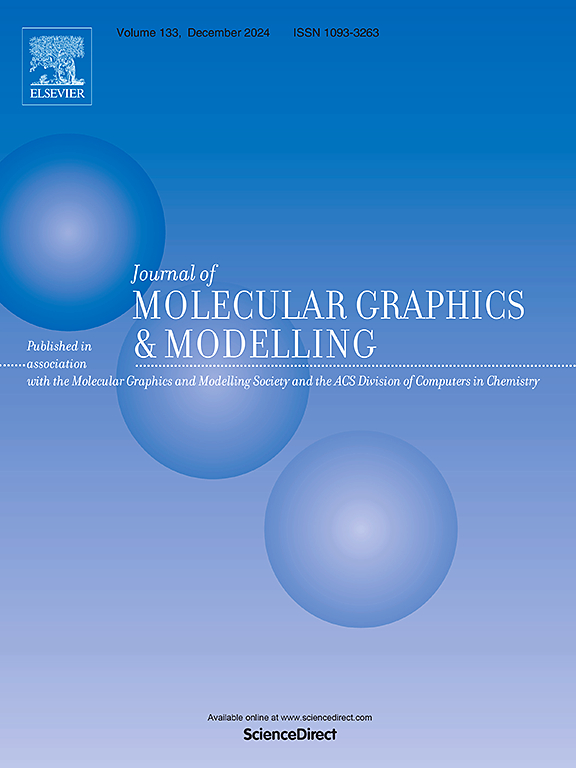Borophene based quasi planar nanocluster for ethanol, isobutanol, and acetone sensing: A first principle study
IF 2.7
4区 生物学
Q2 BIOCHEMICAL RESEARCH METHODS
引用次数: 0
Abstract
In this study, the need for efficient detection of volatile organic compounds (VOCs) in environmental monitoring, industrial safety, is addressed by investigating borophene-based B36 nanoclusters as gas sensors. Density functional theory (DFT) calculations were employed to examine the adsorption behavior of ethanol, isobutanol, and acetone on B36 surfaces, with a focus on vibrational modes, reactivity, and adsorption energies. It was found that acetone exhibits the strongest interaction with pristine B36, indicating its potential for robust sensing applications. To further enhance sensor performance, the effects of doping B36 with nickel (Ni) and iron (Fe) atoms were explored. The electronic structure was significantly modified in Fe@B36, showing strong chemisorption properties, while Ni@B36 showed less impact, serving as a counterexample. Additionally, conductivity, recovery time, and global reactivity parameters were analyzed, providing insights into the sensor's functionality. It is suggested that B36 nanoclusters, particularly Fe-doped systems, offer promising prospects for future gas sensor development and VOC detection.

硼罗芬基准平面纳米团簇用于乙醇、异丁醇和丙酮传感:第一性原理研究。
在本研究中,通过研究硼罗芬基B36纳米团簇作为气体传感器,解决了环境监测和工业安全中挥发性有机化合物(VOCs)有效检测的需求。采用密度泛函理论(DFT)计算研究了乙醇、异丁醇和丙酮在B36表面的吸附行为,重点研究了振动模式、反应性和吸附能。发现丙酮与原始B36的相互作用最强,表明其具有强大的传感应用潜力。为了进一步提高传感器性能,研究了掺杂镍(Ni)和铁(Fe)原子对B36的影响。在Fe@B36中,电子结构发生了明显的改变,表现出较强的化学吸附性质,而在Ni@B36中,电子结构受到的影响较小,可以作为反例。此外,还分析了电导率、恢复时间和整体反应性参数,从而深入了解传感器的功能。B36纳米团簇,特别是掺铁体系,在未来气体传感器和VOC检测方面具有广阔的发展前景。
本文章由计算机程序翻译,如有差异,请以英文原文为准。
求助全文
约1分钟内获得全文
求助全文
来源期刊

Journal of molecular graphics & modelling
生物-计算机:跨学科应用
CiteScore
5.50
自引率
6.90%
发文量
216
审稿时长
35 days
期刊介绍:
The Journal of Molecular Graphics and Modelling is devoted to the publication of papers on the uses of computers in theoretical investigations of molecular structure, function, interaction, and design. The scope of the journal includes all aspects of molecular modeling and computational chemistry, including, for instance, the study of molecular shape and properties, molecular simulations, protein and polymer engineering, drug design, materials design, structure-activity and structure-property relationships, database mining, and compound library design.
As a primary research journal, JMGM seeks to bring new knowledge to the attention of our readers. As such, submissions to the journal need to not only report results, but must draw conclusions and explore implications of the work presented. Authors are strongly encouraged to bear this in mind when preparing manuscripts. Routine applications of standard modelling approaches, providing only very limited new scientific insight, will not meet our criteria for publication. Reproducibility of reported calculations is an important issue. Wherever possible, we urge authors to enhance their papers with Supplementary Data, for example, in QSAR studies machine-readable versions of molecular datasets or in the development of new force-field parameters versions of the topology and force field parameter files. Routine applications of existing methods that do not lead to genuinely new insight will not be considered.
 求助内容:
求助内容: 应助结果提醒方式:
应助结果提醒方式:


